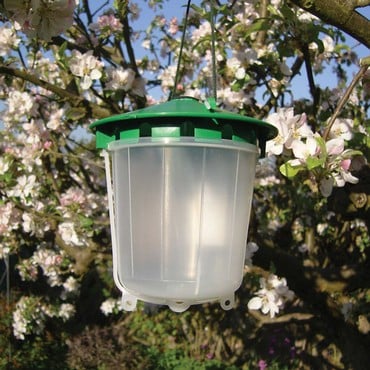The replacement lures for the Plum Fruit Moth Trap each last a season and attract the moths into the trap, saving your precious fruit from pest attack.
Hang the trap in a tree in May and leave in place until August for best results. Replacement lures last for a season and will attract moths over an area of ½ an acre or between 16 to 20 trees.
- Pheromone lure attracts male plum fruit moths.
- Trap is hung in tree in May
- Leave Plum Fruit Moth Trap in place until August
- Each lure lasts a season
- More trapped males means less fertilised females and fewer caterpillars
- Each Plum Fruit Moth Trap covers ½ an acre or between 16 to 20 trees
Product Reviews
First time used Fruit Moth Trap last year on apple tree, quality of high percentage of apples was good. Previous crop was mostly grub infested mainly centre core of apple. Just had to purcase pellet to place in container this year.
trap installed earlier than advised on leaflet and to my great surprise we've got lots of the little moths already!! looking forward to maggot free plums if the weather has permitted fertilization. Excellent product!
for years none of the kids (or wife) will eat the plums for fear of maggots. last year i bought a trap, put it on a bit late (early may - and we'd had an early spring). i don't think i had a single maggotty plum - well pleased! will use it from now on


Caterpillars in the Garden
Our Pest Control Expert, Julian Ives, has spent many years advising commercial growers and gardeners on the subject of safe and efficient natural pest control treatments.
Here he shares his experience on the problems Caterpillars can cause in the garden...
Appearance and Lifecycle
Caterpillars develop from eggs laid by Moths and Butterflies. There are many different species and many that produce caterpillars damaging to plants.
Some of the most damaging for brassica plants are the cabbage white caterpillars; the large cabbage white [Pieris brassicae] and the small cabbage white [Pieris rapae].
The large Cabbage white butterfly is a migratory species but some do manage to overwinter as pupae. The ones that survive the winter appear in March and are then joined by others that migrate from southern Europe. These butterflies then mate and lay their eggs mainly on brassicas and plants like Nasturtiums. The eggs hatch into caterpillars in about 10 days and feed very rapidly. There are normally 2-3 generations per year from March-September. Another damaging species is the Cabbage moth.
Some tips on the appearance of these caterpillars are;
Large Cabbage White: yellow body with dark black markings
Small Cabbage White: Pale green body with soft looking appearance
Cabbage moth: Green-brown bodies with no hair
Fruit trees and ornamentals are subject to attack from other caterpillars including; Codling moth, Plum fruit moth and winter moth. Codling moths appear in late May-June. Their eggs are laid near or on developing fruits from June-July. The emerging caterpillars are small and white with a brown head. Once they finish feeding on fruits they fall from trees to the soil beneath and pupate in the soil ready to overwinter there.
Plum fruit moths follow a similar life cycle. Winter moths emerge from pupae in the soil from November to January. These pupae then crawl up tree trunks to lay eggs but this ascent can be prevented by applying glue bands or insect barrier glue. The eggs hatch when the buds are opening and the developing caterpillars then start feeding. The caterpillars are pale green and about 2-2.5cm long. They stop feeding by early June.
Symptoms and Damage
The caterpillars attacking brassicas can practically destroy vegetable plots. The large Cabbage white eats the outer leaves of vegetable plants and the small Cabbage white caterpillars tend to eat the hearts of plants like cabbages.
Codling moth caterpillars tunnel into the fruits of apples and pears from mid-summer to the autumn. Holes can often be seen on the fruit and the core will be eaten or damaged when you open the fruit up. Plum fruit caterpillars make plums look dehydrated as they feed from within. Winter moth caterpillar damage is first seen in the spring. Leaves are bound together with silk threads and are damaged by feeding. Later in the summer expanded leaves show small holes. Fruitlets can also be damaged and fail to develop fully.
Natural Choice treatments
Prevention and monitoring can play an important part in a strategy to contain and control damage from caterpillars. Netting and fleece can protect plants from egg laying on brassicas and pheromone traps can warn of attack from codling moth and plum fruit moth on fruit trees. A choice of controls is available from either nematode applications or a pyrethrum based spray directly onto the caterpillars.





























